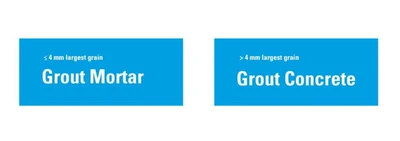Grouting concrete and grouting mortar are highly flowable, cement-based materials specifically designed for force-fit grouting of structural elements. They are characterised by high early and final strength, low shrinkage tendency, and controlled volume expansion.
These properties make them particularly well-suited for applications such as underfilling machine foundations, grouting columns into pocket foundations, filling joints in precast constructions, and repairing concrete components.
Compared to standard concrete and mortar as defined in DIN EN 206-1 and DIN 1045-2, grouting concrete and grouting mortar exhibit significantly higher flowability and a greater proportion of fine particles. This modified composition allows for improved workability and optimised force transmission between components. While grouting mortar contains a maximum grain size of 4 mm, grouting concrete can include aggregates up to 8 mm in size.

Grouting concrete and grouting mortar are used across a wide range of construction sectors:
Grouting concrete and grouting mortar are indispensable for applications requiring high strength, low shrinkage, and excellent workability. Standards and guidelines such as the German DAfStb guideline of 2019 provide a comprehensive framework for the production and application of these materials, ensuring their quality and performance in practice.
With its Emcekrete product systems, MC offers high-performance grouting concretes and mortars for force-fit, void-free grouting in structural, civil, infrastructure, and road construction. From machine foundations to steel structures – Emcekrete stands for permanently stable connections based on 60 years of experience and continuous development.
Interested? Then read more here ...
The DAfStb guideline “Production and Use of Cement-Based Grouting Concrete and Mortar” was published in July 2019 and defines the requirements for these special construction materials in Germany. It specifies, among other things, the compressive strength classes, early strength classes, flow spread values, and permissible layer thicknesses depending on aggregate size.
We are continuously improving our website and we use cookies for this purpose. For an optimal user experience, we recommend that you accept them. Otherwise, parts of the page will be deactivated in the display in accordance with data protection regulations.